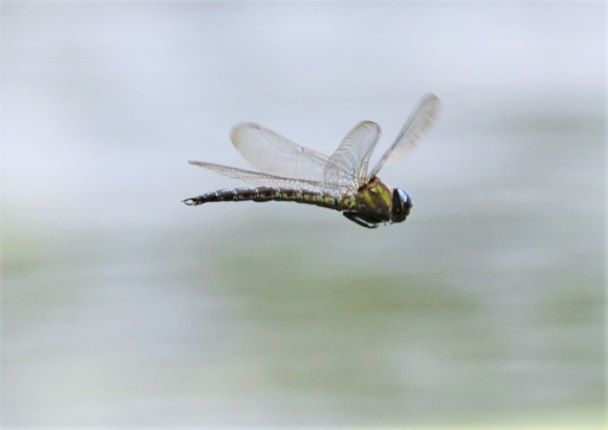
Cyrano Darner Dragonfly
Howdy, BugFans,
It’s time for a dragonfly. In fact, it’s past time for a dragonfly. The BugLady has not seen this species yet (BugFan Freda has, and she contributed her pictures. Thanks, Freda) but she’s looking forward to the end of the rain/sleet/graupel/freezing rain/snow season and to the return of the green so she can look for one.
BOTW has featured the stories of darners (family Aeshnidae) in a number of genera – Common Greens (Anax), mosaic darners (Aeshna), Spatterdock Darner (Rhionaeschna), Fawn Darner (Boyeria), Swamp Darner (Eipaeschna), and Springtime Darner (Basiaeschna). Cyrano Darners are in the primitive darner genus Nasiaeschna, characterized by a stocky body, no “waist,” and a protruding “frons” (literally, the forehead or brow – the front part of the head between the eyes, the antennae, and the mouthparts). Cyrano Darners (Nasiaeschna pentacantha) are the only members of their genus anywhere in the world, and their closest relative here might be the Swamp Darner.
About that name. Yes – this dragonfly was named after Cyrano de Bergerac, a character in a 19th century play. Cyrano had a substantial nose, and this dragonfly’s frons is so protuberant https://bugguide.net/node/view/255298/bgimage that it can even be seen in flight (which is a good thing, because it doesn’t sit still a lot). Kurt Mead, in Dragonflies of the North Woods, suggests an alternative genus name “Schnozz-iaeschna.” “Nasi” means “of the nose,” but the species name, pentacantha (“five spines”), is a little more of a mystery, because females have spines near the tip of their abdomen, but often they have more than five.
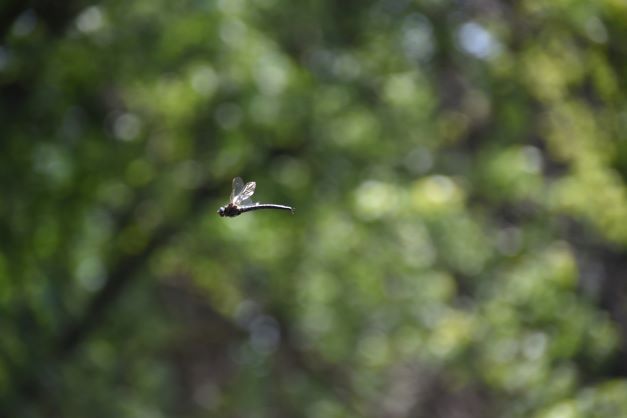
Cyrano Darners are an eastern-ish species https://bugguide.net/node/view/18152/data, and their habitat is sometimes described as “blackwater pools.” They like bottomland forests, lakes, ponds, sluggish streams, and sheltered bays with plenty of leafy and woody debris underwater for their naiads to climb on. The Wisconsin Odonata Survey lists 65 Cyrano Darner observations in Wisconsin, starting in 2009; their status here is a bit wobbly due to their few, scattered populations.
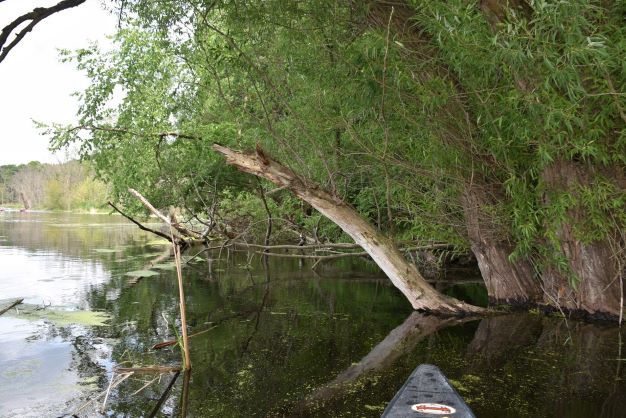
Unlike the much larger Swamp Darner, the 2 ½” Cyrano Darner has geometric, green splotches on its abdomen rather than tidy, green rings, and it has jagged, green stripes on its thorax. Here are more pictures: https://www.marylandbiodiversity.com/view/682.
Cyrano Darners are an early-to-mid-season species, in the air from mid-June through July in Wisconsin. Males fly three to six feet above the water to patrol territories and chase off the competition (one author said that they torpedo intruders, even intruders that are larger than they are), and sources describe their flight as slow, deliberate, and predictable. They often fly with their wings elevated and the tip of their abdomen in a slight downward hook https://bugguide.net/node/view/122070. Unlike other dragonflies, they generally don’t stray too far from water, but Paulson, in Dragonflies and Damselflies of the East, says that they may “cruise back and forth over clearings in forest at about head height but [are] rarely seen to perch, and then often well up in tree.”
Females oviposit solo, inserting eggs into wet logs and soggy stumps below the water line or as high as ten inches above it. Naiads climb around on underwater vegetation and grab passing aquatic insects and small tadpoles and fish by extending their lightning-fast labium (fused mouthparts https://bugguide.net/node/view/250311/bgimage). When it has fed sufficiently, a naiad leaves the water to emerge as an adult. Freda came across a newly minted adult Cyrano Darner that had crawled up onto a stick, shed its final naiad skin and was “unfurling” its wings and abdomen while it perched on the empty shell (exuvia). Its pale colors would intensify over the next few days.
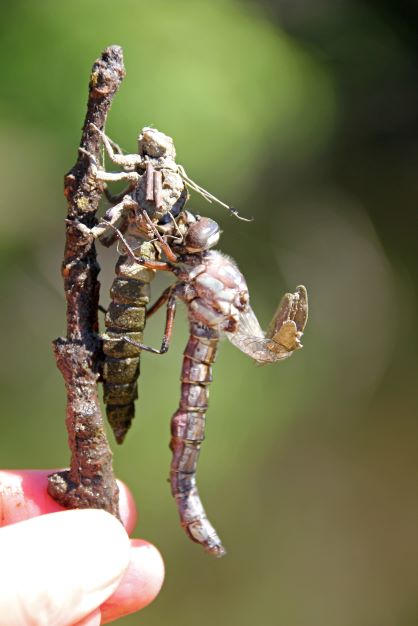
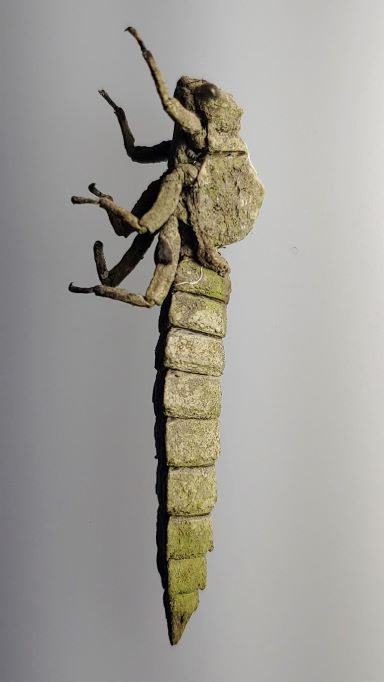
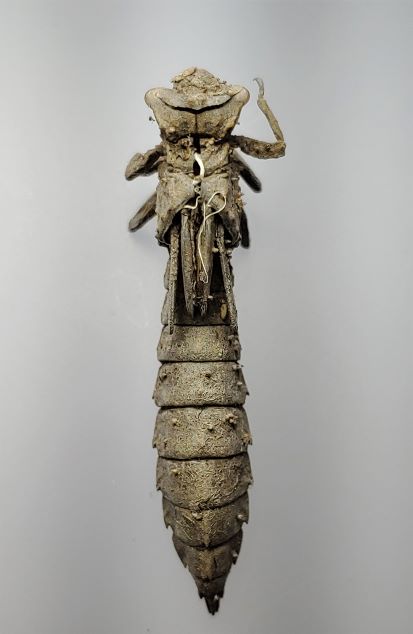
Lots of dragonflies, especially the larger species, grab their prey out of mid-air, but Cyrano Darners are “gleaners” that fly down and pick off insects that are perched on vegetation – an unusual behavior among the darners. They’ll go after some pretty large prey, and they’ll eat fellow dragonflies as large as clubtails. Here’s one feeding on a Roseate Skimmer (which ought to be a sin) https://www.whatsthatbug.com/dragonfly-cannibalism-2/. After plucking it from a branch or leaf, the darner lands and eats its catch (head first, says one source, so it won’t bite them). Cyrano Darners may forage until dusk, but because of their uncommon hunting strategy, they do not join the feeding swarms of dragonflies that follow clouds of midges and other small insects over the grass-tops.
The BugLady recommends the “Dragonflies of Northern Virginia” website, whose author posts great pictures and, in his Notes from the Field, recounts his personal experiences with each species. Cyrano Darners are a favorite of his – check his adventures with this and other species at http://www.dragonfliesnva.com/My%20Documents/KevinPDF/pdf/identify/SpeciesList%20N%20VA-FINAL-HL.pdf.
According to the fine folks at the Springfield Plateau Chapter of the Missouri Master Naturalists (the Cyrano Darner is the emblem of the Missouri Master Naturalists), the Missouri Conservationist publication once offered this advice on how to catch a dragonfly by hand: “Approach them with one hand making erratic circles in front of the insect. A few failures will indicate how close you can get. Slowly move the other hand in from the rear and pick the dragonfly up by its tail. Then switch your hold to its thorax. When calmed down, they will accept and eat offered insects, such as mosquitoes.” “Editor’s note: There were no instructions on how to hold the mosquito you are feeding it.”
Freda wondered if the BugLady could find out what the little lumps are that you can see on one exuvia. Adults have a variety of lumps on their heads, and so do naiads, but the BugLady couldn’t find anything about lumps in other places, so she wonders if something that lived underwater with that naiad might have attached itself to the shell.
Fun Fact about Cyrano Darners: According to Mead, when the naiads are handled, they play dead, looking like a short stick.
Kate Redmond, The BugLady
Bug of the Week archives:
http://uwm.edu/field-station/category/bug-of-the-week/
